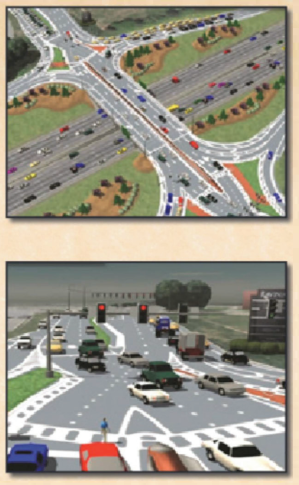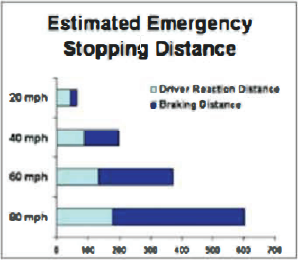
Section 8 Continued: More Safety Guidelines
Carbon Monoxide
Cars produce carbon monoxide, a deadly odorless and colorless gas. Symptoms of carbon monoxide poisoning are sudden weariness, yawning, dizziness, and nausea. Simple precautions to avoid carbon monoxide are:
- Don't leave the car motor running in a garage;
- Don't leave the car motor running and the window closed while the car is parked;
- Don't operate the heater or air conditioner in a parked car with the windows closed;
- Don't drive with a defective muffler or exhaust system.
Move a victim of carbon monoxide poisoning to fresh air, contact emergency medical services, and give artificial respiration if it is necessary and you are trained to do so.

Diverging Diamond Interchange
A Diverging Diamond Interchange (DDI) shifts traffic flow to the opposite side of the road to allow vehicles to enter the freeway by turning left onto an on-ramp without stopping. This reduces points of conflict and improves traffic flow and safety. The DDI is a proven, cutting edge, low-cost design that provides immediate traffic relief. Under normal, free-flowing traffic conditions on surrounding highways, the DDI can reduce delays in evening rush hours up to 20 percent.
View an informative video about Diverging Diamond Interchanges.
Steering Locks
Steering locks are anti-theft devices found in most cars manufactured since 1969.
Steering locks can cause dangerous situations for drivers who are not familiar with their operation. If a vehicle's ignition is placed in the lock position while the vehicle is in motion, the steering capability of the vehicle will be disabled, and the driver will be unable to steer the vehicle.
Further information concerning steering locks is available from the Automobile Safety Foundation.
Following Too Closely
A rear-end crash is caused by following another vehicle too closely. When following another vehicle on any street or highway, there must be enough distance for you to safely stop if the vehicle in front of you suddenly slows down or stops. One way to determine if there is enough distance between your vehicle and the vehicle in front of you is to measure the amount of time between when the vehicle in front of you passes a reference point and when your vehicle passes the same reference point. Watch the car ahead of you. When it passes a reference point, such as a telephone pole or street sign, count "one-thousand-one, one-thousand-two." If you pass the same spot before you are through counting, you are following too closely. During inclement weather, during construction, during heavy traffic, and always at night, the distance between your vehicle and the vehicle in front of you should be even greater.
Speed and Stopping Distance
The distance it takes to stop your vehicle is important in determining a safe driving speed. The chart titled "Estimated Emergency Stopping Distance" may be used as a guide, but actual stopping distance can depend on the following factors in addition to vehicle speed:
Estimated Emergency Stopping Distance

- Mental and physical reaction of the driver;
- Type and condition of the pavement;
- Kind of tires and tread composition;
- Chassis (frame) design;
- Type of brakes, condition, and balance of brakes;
- Wind direction and velocity.
Speed is a leading factor in serious injury and death as a result of traffic crashes. The greater the speed, the greater the force of impact. The illustration titled "Driving off a building" conveys the relative force of impact when you strike a fixed object.
Driving off a building

Striking something at these speeds is like driving off a one, four or nine story building